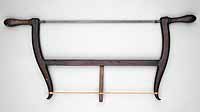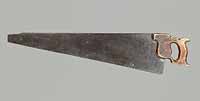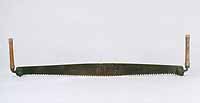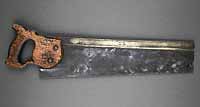Page content
Saws
Complex tools
Of all hand tools used by 18th-century woodworkers, saws were among the most technically complex to manufacture. To work well, saw blades had to maintain a delicate balance of hardness so that they would stay sharp, stiffness so that they could be pushed through the work, flexibility so that they would bend and not break under stress, and smoothness of surface so that they would not bind in the cut.
Saws date back 5,000 years
Saws have been used to cut wood for more than 5,000 years. In the 18th century, they were made in a variety of shapes and sizes designed for different jobs. Woodworkers used large saws to cut wood into planks, boards, and veneers. Smaller saws were used to cut boards into parts, to cut joints, and to make decorative piercings.
Compass saws had narrow, pointed blades that allowed them to be started through small drilled holes. They were used to saw holes in the middle of boards and pierced work such as chair splats.

Framed saws had their blades mounted inside wooden frames. The frames stretched the blade tight and allowed the use of longer, thinner blades. The bow saw was used by cabinetmakers and joiners to make curved cuts.

The felloe saw was used by wheelwrights for cutting the curved wooden segments of wheels and by chairmakers for sawing curved chair arms and legs.



